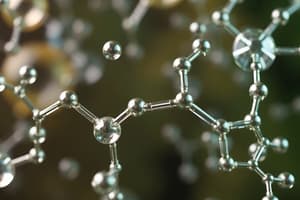Podcast
Questions and Answers
What characteristic distinguishes α-amino acids from other organic compounds?
What characteristic distinguishes α-amino acids from other organic compounds?
- Presence of multiple carboxyl groups
- Presence of only aliphatic R groups
- Presence of an amino group and a carboxyl group on the same carbon (correct)
- Presence of a hydroxyl group
Which type of amino acid contains both a carboxyl group and an ionizable amino group?
Which type of amino acid contains both a carboxyl group and an ionizable amino group?
- Neutral amino acids
- Acidic amino acids (correct)
- Basic amino acids
- Aromatic amino acids
Which amino acid is classified as neutral and has the R group as a methyl group?
Which amino acid is classified as neutral and has the R group as a methyl group?
- Glycine
- Serine
- Alanine (correct)
- Valine
What defines saturated fatty acids compared to unsaturated fatty acids?
What defines saturated fatty acids compared to unsaturated fatty acids?
What is a lipid that has both glycerol and fatty acids found esterified together?
What is a lipid that has both glycerol and fatty acids found esterified together?
Which of the following lipids is likely to remain liquid during winter months due to its melting point?
Which of the following lipids is likely to remain liquid during winter months due to its melting point?
Which class of amino acids includes tryptophan and phenylalanine?
Which class of amino acids includes tryptophan and phenylalanine?
What is a common example of a phospholipid found in cell membranes?
What is a common example of a phospholipid found in cell membranes?
Flashcards
Amino Acids
Amino Acids
Organic compounds with an amino group (-NH2) and a carboxyl group (-COOH) attached to the same carbon (alpha carbon).
R Group
R Group
The variable group attached to the alpha carbon in an amino acid. It determines the amino acid's properties.
Hydrophobic Amino Acid
Hydrophobic Amino Acid
A type of amino acid with a non-polar, hydrophobic R group.
Hydrophilic Amino Acid
Hydrophilic Amino Acid
Signup and view all the flashcards
Fatty Acid
Fatty Acid
Signup and view all the flashcards
Saturated Fatty Acid
Saturated Fatty Acid
Signup and view all the flashcards
Unsaturated Fatty Acid
Unsaturated Fatty Acid
Signup and view all the flashcards
Triglyceride
Triglyceride
Signup and view all the flashcards
Study Notes
Amino Acids
- Organic compounds with an amino group and an acidic group on the same carbon (α-carbon), making them α-amino acids.
- Substituted methanes with four substituents: hydrogen, carboxyl group, amino group, and a variable R group.
- Many amino acids exist, but only twenty are found in proteins.
- The R group varies, determining the specific amino acid (e.g., glycine with hydrogen, alanine with methyl group).
- Chemical and physical properties largely depend on the amino, carboxyl, and R groups.
- Classified as acidic (e.g., glutamic acid), basic (lysine), or neutral (valine) based on the number of amino and carboxyl groups.
- Also categorized as aromatic amino acids (tyrosine, phenylalanine, tryptophan).
- Amino acids are ionizable, changing structure in different pH solutions.
Lipids
- Generally water-insoluble organic compounds.
- Simple lipids include fatty acids with a carboxyl group attached to an R group.
- R group can be methyl, ethyl, or longer hydrocarbon chains (1-19 carbons). Examples include palmitic acid (16 carbons) and arachidonic acid (20 carbons).
- Fatty acids can be saturated (no double bonds) or unsaturated (one or more double bonds).
- Another simple lipid is glycerol (trihydroxy propane).
- Many lipids combine glycerol and fatty acids, and the fatty acids are esterified to glycerol.
- These combinations are monoglycerides, diglycerides, and triglycerides ( fats and oils based on melting point).
- Oils have lower melting points (e.g., gingelly oil) and remain liquid in cooler temperatures.
- Phospholipids contain phosphorus and a phosphorylated organic compound, crucial for cell membranes (e.g., lecithin).
- Some lipids have complex structures, particularly in neural tissues.
Nucleic Acids
- Living organisms have carbon compounds with heterocyclic rings, including nitrogenous bases (adenine, guanine, cytosine, uracil, and thymine).
- When attached to a sugar, these nitrogenous bases are called nucleosides (e.g., adenosine, guanosine).
- Nucleotides are nucleosides with a phosphate group esterified to the sugar. (e.g., Adenylic acid, thymidylic acid).
- Nucleic acids (DNA and RNA) are polymers of nucleotides.
- DNA and RNA serve as genetic material.
Studying That Suits You
Use AI to generate personalized quizzes and flashcards to suit your learning preferences.




